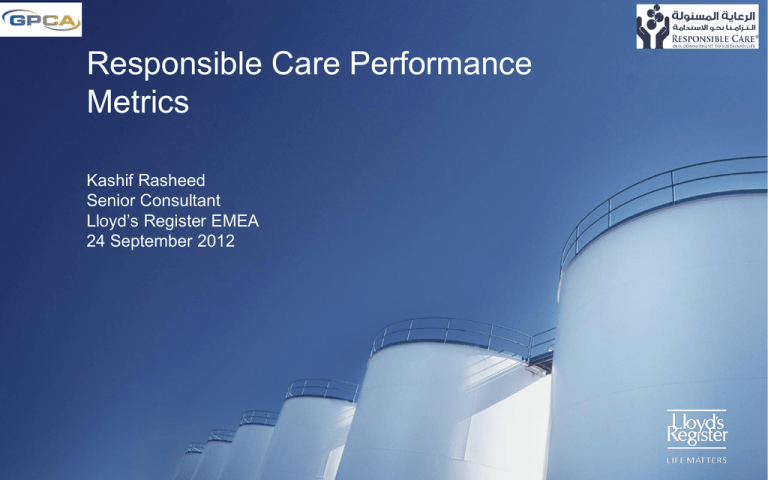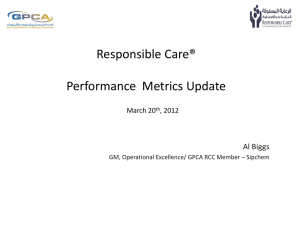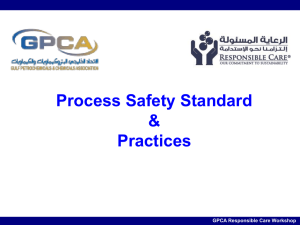sipchem_gpca_metrics_presentation_rev01
advertisement

Responsible Care Performance Metrics Kashif Rasheed Senior Consultant Lloyd’s Register EMEA 24 September 2012 Responsible Care Performance, Metrics Definitions, Data Analysis, Results and Q&A 2 • Background • Guidance Document Overview and EH&S Performance Measurement Categories • Scope of data received and analyzed • Value of Metrics, Definitions and Data set analysis by Category • Summary Background • Lloyd’s Register being a third party and having extensive experience in independent assurance reviews, was assigned with responsibility to gather, analyze and benchmark this data for today’s workshop. • Lloyd’s Register was provided data without companies identification. • LR Team worked with the RC Metrics sub-committee to develop the contents of this workshop. • All data inputs provided by GPCA member companies are treated without any modifications/corrections. 3 Guidance Document Overview and EH&S Performance Measurement Categories • • 4 Content of Guidance Document: • Metric Value • Units of the Metric • Definitions • Member Reporting Instructions 5 Categories (21 Indicators) • Occupational Safety (6) • Process Safety(3) • Emissions / Discharges to Environment (8) • Resource Utilization (3) • Distribution Incidents (1) GPCA Metrics Current Template GPCA Company Name: S.No Report for the Year: Metric Name A. Occupational Safety 1 Employee Fatalities # of Fatalities 2 Lost Time Injury Incident rate for Employees (# of days away from work cases X 200,000) / Employee man-hours worked 3 OSHA Recordable Cases Incidence Rate for Employees (# of Injuries X 200,000) / Employee man-hours worked 4 Contractor Employee Fatalities # of Fatalities 5 Lost Time Injury Incidence Rate for Contract Employees (# of Injuries X 200,000) / Contractor man-hours worked 6 OSHA Recordable Cases Incidence Rate for Contract Employees (# of Injuries X 200,000) / Contractor man-hours worked B. Process Safety 1 Process Safety Incidents (# of Incidents that meet the Process safety Incident Criteria 2 Process Safety Total Incident Rate (PSTIR) (# of Process Safety Incidents x 200,000) / (Employee + Contractor Employee man-hours) 3 Process Safety Total Incident Severity Rate (PSTIR) (Total Severity Score x 200,000) / (Employee + Contractor employee man-hours) C. Emissions / Discharges to Environment 1 Hazardous Waste for Disposal Metric tons / Year 2 Non-Hazardous Waste for Disposal Metric tons / Year 3 Quantity of Waster Water discharged to Environment Cubic Meters / Year 4 Discharges to Water - Chemical Oxygen Demand Metric tons of O2 / Year 5 Sulfur Dioxide Metric tons / Year 6 Nitrogen Oxides (NOX) Metric tons / Year 7 Total Green House Gas Emissions (GHG) Metric tons CO2 Equivalent (See Appendix C & D & E) 8 Carbon Dioxide (CO 2) Intensity Million Metric tons emitted per year / Million Metric tons of production D. Resource Utilization 1 Use of Energy (Tons of Fuel oil Equivilant; TOE) Energy from Fossil Fuels + Net Energy Purchased + Self Generated Renewable Energy 2 Specific Energy Consumption TOE / Metric tons of production 3 Process Water Consumption Millions of Cubic Meters E. Product Distribution 1 No of Distribution Incidents Phase I - 2010 Data to be reported by September 2011 Phase II - 2011 Data to be reported by March 2012 Phase III - 2012 Data to be reported by March 2013 Phase IV - Potential Metric for 2014 5 Metric Formula / Definition Total # of Incidents classified by means of transport GPCA Member Company Annual Report Gulf Petrochemicals & Chemicals Association-GPCA GPCA Members-Performance Metrics-Consolidated Metric Name Employee Fatalities Lost Time Injury Incident rate for Employees OSHA Recordable Cases Incidence Rate for Employees Contractor Employee Fatalities Process Safety Incidents Process Safety Total Incident Rate (PSTIR) Hazardous Waste for Disposal Non-Hazardous Waste for Disposal Quantity of Waster Water discharged to Environment Discharges to Water Chemical Oxygen Demand Process Water Consumption Performance Metrics - 2010 Assigned PM Key A1 A2 A3 A4 B1 B2 C1 C2 C3 C4 D3 M-02 0 0.08 0.41 0 0 0 20,840 453 0 0 3.03 M-03 0 0 0 0 0 0 15.98 31.20 76,530.50 NR 0.18 M-04 0 0.705 1.41 0 NR NR 0 592 128,604 NR 1.7073 M-05 0 6.07 0.21 0 0 0 140 120 109,000 1.7 0.331 M-06 0 0 0 0 2 0.42 91 250 526,220 7.48 0.684 M-07 0 0 0 0 0 0 301.7 206.6 334,103,112 20,046.2 1.606 M-08 0 2.45 0.22 0 NR NR 110.28 28 642,204 NR 1.15 M-10 0 0.036 0.14 0 0 0 223.388 139.008 1,473,660 177 4.46 M-11 0 0 0 0 15 0.08 342 656 912,300,856 79 2.87 M-13 0 0.22 1.16 0 0 NR 143.43 445.4 1,270,200 29.72 2.08664 M-16 0 0 0.42 0 NR NR 227 62 NR 152 1,116,216 M-17 0 0 0.32 0 NR NR 142,122 6,188 2,086,555 156.5 4.37 M-18 NR 0 0.28 NR 0 0 1,308 616 47,249 NR 1.09 M-19 1 0.20 0.26 4 8 0.15 377,544 100,289 5,892,925 133,360 44.37 M-20 0 6.03 0.26 0 NR NR 34,667 222.5 0 0 7.2 M-21 0 0 0.07 0 NR NR 4,919 1,802 0 0 7.44 M-23 0 0.00 0.00 0 NR NR 576 268 0 0 1.53 M-25 0.0 0.0 0.0 0.0 NR NR 18654 0.0 0 0.0 1.53 M-26 0 0 0 0 0 0 1460 0 0 13.92 0.69 M-29 0 0 0.2086 0 0 0 748 888 380,454,181.5 0 8,423.6 603,856 112,989 1,639,111,297 154,023 1,124,726 Full Members 6 Total Legend: NR - NOT REPORTED Comments 7 2010 EH&S Data Received Phase I Submittals 90 Required Reported 97.5% 80 93.75% 70 60 80 50 78 80 75 40 30 57.5% 40 20 23 10 0 Occupational safety (6) 20 / 24 companies participated 8 Process Safety (3) Emissions/Discharges (6) 2011 EH&S Data Received Phase II Submittals 100 % 120 Required 93.8% Reported 100 114 80 114 114 107 96.5% 60 80.7% 57 40 57 55 46 20 0 Occupational safety (6) 19 / 24 companies participated 9 Process Safety (3) Emissions/Discharges (6) Resource Utilization (3) 2010/2011 EH&S Data Received 400 350 Required 94 % Reported 300 250 342 88 % 200 150 100 200 322 176 50 0 2010 Phase I 10 2011 Phase II Occupational Safety 11 Value of Occupational Safety Metrics • They are important to stakeholders. • They are measures of the most severe and significant safety factors. • They are proven safety metrics, universally used. • They can be used as a basis to demonstrate performance improvement. • They have high benchmarking value 12 Occupational Safety Definitions • Employee Fatalities: Death, regardless of the time between injury or exposure and death or length of the illness, caused by a work-related event or exposure • Recordable Injury Incident Rate: Defined as the number of OSHA recordable incidents for each 100 full-time employees per year based on 2,000 hours worked per employee per year. Annual # of Recordable Injury Cases x 200,000 employee hours Annual number of employee hours worked • Lost Time Injury Incident Rate: Defined as the number of lost workday Injury incidents for each 100 full-time employees per year, based on 2,000 hours worked per employee per year Annual # of Days Away from Work Cases x 200,000 employee hours Annual number of employee hours worked 13 GPCA Member Company, Occupational Safety Data Set Analysis (TRIR=Total Recordable Incident Rate) Arithmetic AVG.* = 0.27 7 Reporting Zero *TRIR AVG. derived from taking actual average instead of using incidents and man-hours Key Messages: TRIR low for most companies and 35% report a “zero” incident rate 14 Actual AVG. TRIR = 0.17 Arithmetic AVG. * = 0.426 GPCA Member Company, Occupational Safety Data Set Analysis (TRIR=Total Recordable Incident Rate) 2011 TRIR for Contractor Employees TRIR AVG.* 0.34 7 Reporting Zero *TRIR AVG. derived from taking arithmetic average instead of using incidents and man-hours Key Messages: TRIR low for most companies and 37% report a “zero” incident rate 15 2010 and 2011 Occupational Safety Performance Benchmarks 16 2010-2011 Key Messages - Occupational Safety • Actual number of injuries and man-hours worked are needed to calculate GPCA overall TRIR • In 2010 88% of the data requested for this category was received from 83% of member companies (20 out of 24) • In 2011 100% of the data requested for this category was received from 79% of member companies (19 out of 24) • A large percentage of GPCA companies report a zero incident rate. • Some inconsistencies in data set indicate a need for uniform understanding of definitions (22 LTIs & 6 Recordables, 10 LTIs and 4 Recordables) 17 Occupational Safety Panel Q&A 18 Process Safety 19 Process Safety – Value of Metrics • Are important to stakeholders • Provide a measure to benchmark across industry • Demonstrates performance improvements 20 Process Safety Incident An unplanned or uncontrolled release of any material, from a process that results in one or more of the consequences listed below: 21 1. An employee or contractor LTI, and/or fatality, or hospital admission and/or fatality of a third party (non-employees/contractor). 2. An officially declared community evacuation or community shelter-in-place; 3. Fires or explosions resulting in greater than or equal to $25,000 of direct cost to the company, or; 4. An acute release of flammable, combustible, or toxic chemicals greater than the chemical release threshold quantities Process Safety Definitions ……Cont. • Process Safety Incident Count (PSIC): The count of all incidents which meet the definitions of a Process Safety Incident. • Process Safety Total Incident Rate (PSTIR): The cumulative (annual) count of PSI normalized by man-hours. Number of PSI in a year x 200,000 Total Man-hours Employees & Contract Employees • Process Safety Incident Severity Rate (PSISR): The cumulative (annual) severityweighted rate of Process Safety Incidents PSI normalized by man-hours. Total Severity Score for all PSI in a year x 200,000 Total Man-hours Employees & Contract Employees 22 What Is Severity Level? Consequences of PSI Incident Severity Level from CCPS Table 2 Recordable Injury to Employee or Contractor 4 Lost Word Day ( Lost Time) Injury 3 Fire or explosion resulting in direct cost 100,00 to 1 Million $ 3 On Site Fatality employee or contractor 2 Fire or explosion resulting in direct cost > 10 million $ 1 23 GPCA Member Company, Process Safety Data Set Analysis 2011 Number of Process Safety Incidents 25 Not Reported : 8 9 reporting zero Not Reported: 3 9 reported zero 20 15 10 5 0 0 2 4 6 8 10 12 14 16 18 20 Key Messages: Wide variance in numbers reported indicate understanding needed on definitions & Data capturing. 24 2010-2011 Key Messages Process Safety • Data not sufficient to establish trends or use as benchmarks. • Additional data sets to be requested to make meaningful comparisons. • Members to review their internal systems for data capturing/recording. 25 Process Safety Panel Q&A 26 Environmental Emissions/Discharges 27 Emissions and Discharges Value of Metrics: 28 • Hazardous and Non Hazardous Waste for Disposal: primarily a measure for the efficient use of resources • Discharge to Water - Quantity & Chemical Oxygen Demand: reflects the potential adverse impact on the aquatic environment • Sulphur Oxides (SOx) and Nitrogen Oxides (NOx): This core measure is identified in the Responsible Care Global Charter. • It is important to external stakeholders and relatively easy for members to report. • It is a regulatory requirement in most areas. • Discharge to Water - Quantity & Chemical Oxygen Demand (COD): Waste water discharged to the environment directly or through a third party water treatment facility and the amount of COD in the discharged waste water. • Sulphur Oxides (SOx) and Nitrogen Oxides (NOx): Annual emissions inventory for criteria pollutants, NOx and SOx, for those company sources within facilities that are required to prepare and submit annual emissions inventory as per their respective permitting / regulatory requirements 29 Environmental Data Reporting – 2010 & 11 Environmental Data Rquired 120 100 80 60 40 20 0 Reported Data inputs by GPCA Members 82 % 85 % 80 94 68 2010 30 114 2011 Emissions and Discharges Key Messages • In 2010 94% of the data requested for this category was received from 83% of member companies (20 out of 24!) • In 2011 94 % of the data requested for this category was received from 79% of member companies (19 out of 24!) • Extreme variations in submitted data – possible need for understanding of metric definitions. • Data quality/quantity not sufficient for benchmarking 31 Environmental Emissions & Discharges Panel Q&A 32 Resource Utilization 33 Resource Utilization Value of Metric: • • 34 Energy Efficiency: It is an important measure for global stakeholders. • It is also tracked by many other reporting tools and systems. • This speaks to sustainability issues. Process Water Consumption This ICCA core measure is identified in the Responsible Care Global Charter. • This is important to external stakeholders. • It is also a clear new generation metric. Resource Utilization Definitions Use of Energy (Tons of Fuel oil Equivalent; TOE) Total energy consumed at GPCA member company facilities. • This includes purchased non feedstock power and energy from combustion of waste or by product streams. • Energy recovered from the process is not considered as consumed energy. • Detailed calculation methodology is attached to the guidance document Process Water Consumption : The total amount of water pumped, piped, or otherwise brought on site for use in manufacturing activities and not returned to the water source from which it was withdrawn. 35 Resource Utilization - Data Set Analysis 60 50 94.7 % Data Inputs Required Data Inputs Reported 57 40 54 30 100 % 20 10 20 20 0 2010 2011 Key Message: Data Sets with huge variations demands a better understanding of metrics definitions. 36 Resource Utilization Panel Q&A 37 Summary • Quantity of Data inputs received are encouraging • Analysis identifies the need for a better and uniform understanding of the metrics definitions • Use this workshop to share and learn from each other • Contractors engagement for this campaign is essential. 38











